Table of contents
Animal: swallow
Family: hirundinids (hirundinidae)
Group: birds
Genre: lanius (laniidae)
Order: passerine
Habitat: marshes, meadows, forests and open areas near water
Territory: Europe and Asia, and North and East Africa.
Size: between 15 and 20 cm
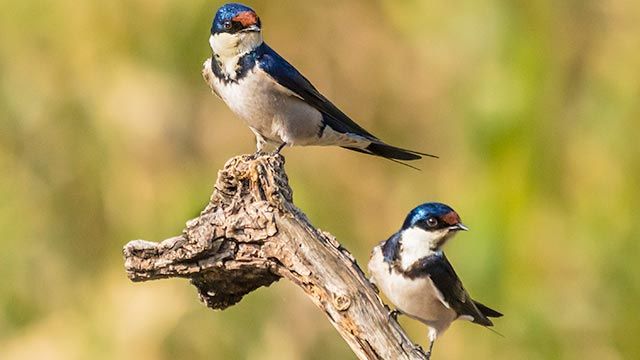
The barn swallow o hirundo rustica is a bird of the hirundinidae family that is characterized by its beautiful and shiny dark blue feathers and its cheerful and pleasant songs. It is one of the most common birds of the most common migratory birds and It is the one in charge of welcoming spring with its return, and it is easily skilled in all flights and is able to drink and eat without stopping to fly.
Characteristics of the swallow
The barn swallow is a small bird The bird stands out for its bright dark blue plumage and forked tail with outer feathers more elongated than the inner ones. Small white spots can be seen on these feathers and its chest can be white with orange or light red tones.
It is usually 19 cm long but can vary in size between 15 and 20 cm and weighs between 15 and 25 grams.
On the other hand, the beak is tiny and around it (on the forehead and throat) there is a reddish color that differentiates it from the others. hirundinid birds Its eyes are black and its long legs allow it to perch horizontally, making it easier for it to soar from the ground.
Another curious appearance of the swallow It is part of the animals that hibernate in winter to survive, although it should be noted that it is not considered a complete hibernation and only hibernates for a short period of time.
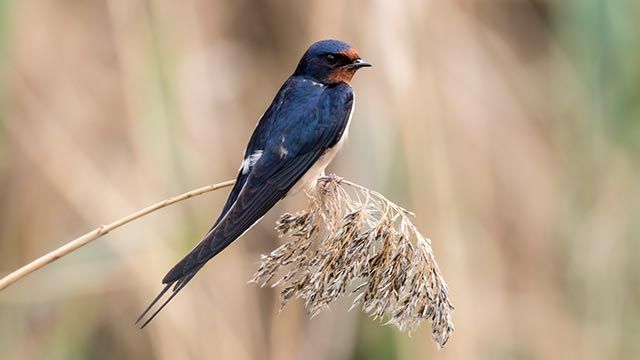
What the Barn Swallow eats
This bird has a insectivorous feeding It feeds on insects such as flies, mosquitoes, moths, flying ants, crickets, beetles, butterflies, dragonflies and grasshoppers, among others. One of its characteristics is its particular way of obtaining food for survival. It does so by gliding along the ground or shallow water surfaces, catching and swallowing its prey without stopping its flight.
They also do not stop to drink, so it is common to observe them skimming the water of rivers and lakes without stopping to fly. Therefore, it is a bird that spends most of the day flying. Something curious is that it is also capable of feeding its chicks while it flies.
They usually hunt in groups except during the breeding season, when they hunt in pairs. And during the cold seasons, they hunt in pairs. more difficult to obtain food We provide you with some ideas to help your birds in winter, they will thank you for it!
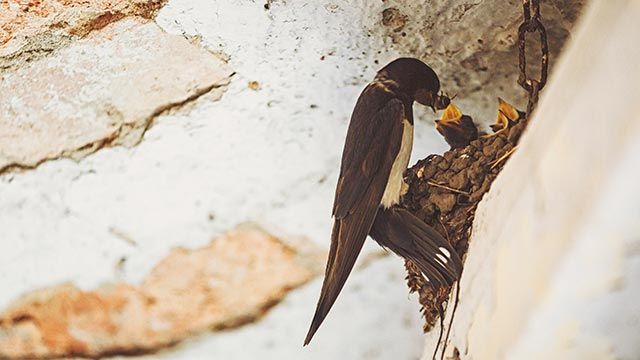
Swallow reproduction
The swallow is a faithful animal to its mate, so once paired they will be together for life. However, the male has to work on his courtship and present himself properly with his reddish throat colors, his correct weight and long tail feathers. In this way, the female will find him attractive and will not leave with another.
As for reproduction, it usually lays between 5 and 6 eggs and once they hatch they remain in the nest for 22 days. During this period, both the female and the male take care of feeding the chicks and the best thing is that they can do it without stopping flying.
After this period of time has passed, the hatchlings will start to take flight and learn to fly little by little. Even so, given that they are nesting chicks Even if they leave the nest, their parents will continue to feed them for a long time.
How to differentiate male and female swallows
Although the appearance of the female swallows and the male swallows For example, the male's feathers are longer than the female's and the blue color of its chest and back is brighter.
In addition, males usually have dark red spots on the throat and forehead, and females have lighter red spots.
On the other hand, it should also be noted that the young swallow It is usually brown with white parts and a reddish face, and its tail feathers are usually shorter than those of adults.
How to differentiate between swifts and swallows
It is very easy to recognize a swallow There are clear differences:
- The swallow's tail is longer than that of the swift.
- The swift's throat color is white while the swallow's throat color is red.
- The color of the swallow's plumage is dark blue and shiny while the swift's is grayish black.
- The swallow usually performs more maneuvers and acrobatics during its flight.
- The swift flies faster and more linear than the swallow.
- Swift flights are higher.
- The swift emits a short, monotonous screech as it flies.
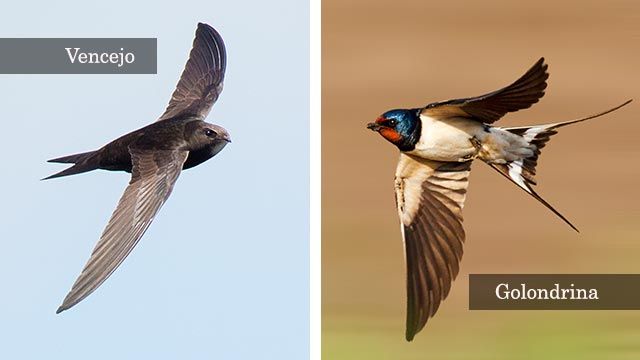
How is the sound of the swallow
The swallow's song It is usually heard while preparing their nests with mud, when they are looking for horizontal perches to teach their chicks to fly or during their flights.
If you want to know how the swallow sounds Click on the audio below!
Ximena Martinez Ayala - Sound of the SwallowsWhen the swallows leave
The swallow is a bird announcing the beginning of spring This is because they are always in search of warm places, for example, in late summer and early autumn they undertake a long journey to spend the winter in Africa, South America or northern Australia and return when the good weather returns.
Therefore, the swallow migrates With the arrival of autumn and returns with the beginning of spring, it is part of the different migratory birds that appear in spring.
What do swallows indicate
The return of the swallows This is the reason why it is so common to see them fly away with the arrival of spring and to see them leave when autumn approaches.
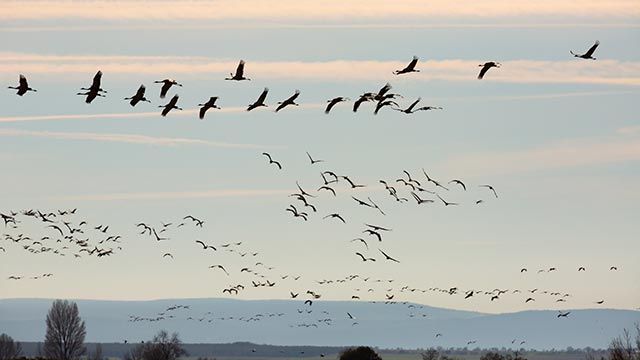
How long a swallow lives
The swallow is a bird with a short life expectancy This is even true for the hatchlings, as only 30% of the chicks that hatch survive the first year of life.
What to do when a swallow falls out of the nest
Spring and summer are seasons in which the breeding season prevails, and it is possible that some of the chicks fall out of the nest Therefore, it is important to know how to act if you find an orphaned chick and follow the recommended steps. In the previous article we also told you about how to feed a swallow .
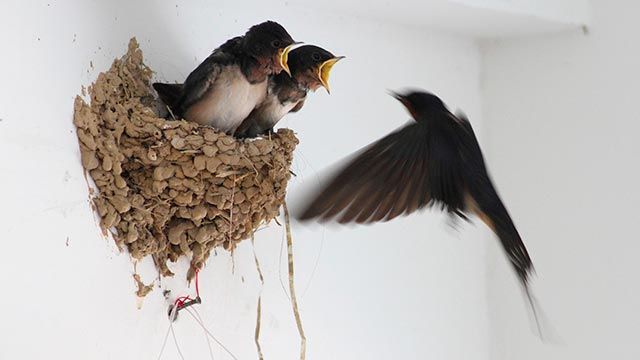
What to do if you have swallow nests
Destroying the nests of swallows, swifts or airplanes is completely illegal because they are protected birds Removing or destroying nests can result in a fine of up to 200,000 euros.
So, if you ever you find a nest on your land It is advisable to contact the regional environmental, flora and fauna authorities and to prepare a request for management of flora and fauna populations in the natural environment .
Types of swallows
There are 75 swallow species divided into 19 genera and classified according to the following characteristics:
- The shape of the nest: circular with an elongated tube, plate-shaped, etc.
- The color of their feathers: black, black and white, bicolor...
- Size: ranging between 10 and 20 centimeters.
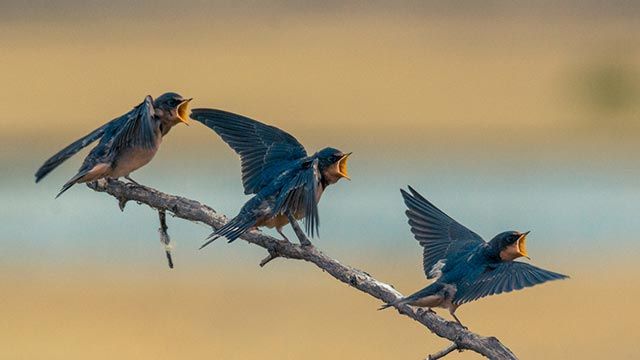
Curiosities about the swallow
- The swallow announces the beginning of spring.
- Its feathers have a shiny, metallic dark blue color.
- It usually hunts and eats while flying.
- It is able to feed its chicks without stopping to fly.
- It is a bird with a short life expectancy: it lives only 4 years and 70% of the chicks do not survive after hatching.
- It can hibernate in winter to survive (although it does so for a short time).
- It is a bird faithful to its mate.
Do you want to know which is the smallest bird in the world Don't miss all the characteristics and curiosities of the hummingbird!

